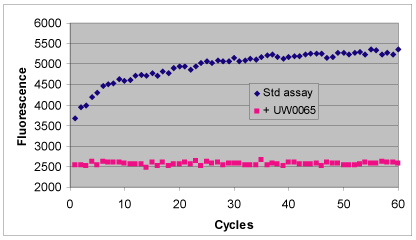Inhibitor of deSUMOylating enzymes (SENPs). SUMO-2 aldehyde is a highly specific inhibitor of SENP enzymes and has utility in the stabilisation of SUMO-protein conjugates in vitro, enhancing their accumulation in cell lysates and tissue extracts. In addition, co-crystallisation of yeast SUMO (Smt3) aldehyde with the yeast deSUMOylating enzyme Ulp1 has been used to probe the enzyme: substrate interactions, so human SUMO-aldehydes may therefore be of similar utility, and SUMO-2 aldehyde may be used in conjunction with SUMO-1 aldehyde to probe the SUMO paralogue preference of SENP enzymes.
Product Details
| Alternative Name: | Sentrin-2 aldehyde |
| |
| MW: | ~10.5kDa |
| |
| Source: | Produced in E. coli cells. Derivatised chemically, in vitro. |
| |
| UniProt ID: | P55854 |
| |
| Concentration: | 1mg/ml |
| |
| Formulation: | Liquid. In 0.15M HCl. |
| |
| Purity: | ≥95% (HPLC) |
| |
| Quality Control: | SUMO-2 aldehyde activity was confirmed by its inhibition of SENP1 (Prod. No. BML-UW9760) deSUMOylation of SUMO2-AMC (Prod. No. BML-UW0045).
Typical assay set-up:
Substrate concentration: 0.1-2.0μM.
Enzyme concentration: 0.1-1µM.
Inhibitor concentration: 0.1-2.0µM.
Release of AMC fluorescence by DUB enzymes can be monitored spectrophotometrically using 380nm excitation and 460nm emission wavelengths. Concentration determination: SUMO-2 aldehyde sample concentration determined by measurement of absorbance at 280nm by spectrophotometry, and comparison with a SUMO-1 calibration curve produced by serial dilution (2.0-0.125mg/ml). |
| |
| Application Notes: | Suggested uses:
- Stabilisation of SUMO-protein conjugates in cell lysates and tissue extracts.
Determination of inhibition kinetics for specific deSUMOylating enzymes.
Co-crystallisation with specific deSUMOylating enzymes for structural studies
Probe for investigating enzyme:substrate interactions.
Used in conjunction with SUMO-1 aldehyde to probe the SUMO paralogue preference of SENP enzymes
|
| |
| Shipping: | Blue Ice Not Frozen |
| |
| Short Term Storage: | +4°C |
| |
| Long Term Storage: | +4°C |
| |
| Use/Stability: | Soluble and stable in aqueous solution at pH ≤7.0. Avoid presence of amino-containing compounds. Do not lyophilize. Do not neutralize until immediately prior to use. Stable for at least 2 months after receipt when stored at +4°C. |
| |
| Handling: | Do not freeze. |
| |
| Scientific Background: | SUMO proteases (SENPs) contribute to three distinct activities in the cell, processing SUMO precursors to generate mature SUMO, depolymerization of SUMO chains, and deconjugation of SUMO modified proteins. Cleavage occurs after the conserved SUMO Gly-Gly motif either at the scissile peptide bond during processing or at the scissile isopeptide bond during depolymerization and deconjugation. The six human SUMO specific SENP enzymes (1-3, 5-7), have been shown to participate in non-redundant cellular functions such as HIF1-α stabilization during hypoxia, mitosis and cytokinesis. |
| |
| Technical Info/Product Notes: | ATTENTION: There is confusion within the scientific literature (including NCBI and UniProt protein databases) concerning the nomenclature used for SUMO2 and SUMO3 paralogs. Please note that Enzo Life Sciences uses the nomenclature proposed by Saitoh and Hinchey [J. Biol. Chem, 275, 6252-6258 (2000)] for SUMO-2/SMT3A and SUMO-3/SMT3B and reports data accordingly. |
| |
| Regulatory Status: | RUO - Research Use Only |
| |

SENP Assay (typical): 0.5µM SENP1 Catalytic Domain (His) (Prod. No. BML-UW9760); 2µM SUMO2-AMC (Prod. No. BML-UW0045); 2µM SUMO-2 aldehyde (Prod. No. BML-UW0065); 20mM TRIS-Cl, pH8.0, 20mM NaCl, 5mM DTT.
Please mouse over
General Literature References
Modification in reverse: the SUMO proteases: D. Mukhopadhyay & M. Dasso; Trends Biochem. Sci.
32, 286 (2007),
Abstract;
SUMO-specific protease 1 is essential for stabilization of HIF1alpha during hypoxia: J. Cheng, et al.; Cell
131, 584 (2007),
Abstract;
SUMO protease SENP1 induces isomerization of the scissile peptide bond: L. Shen, et al.; Nat. Struct. Mol. Biol.
13, 1069 (2006),
Abstract;
SUMO-specific proteases and the cell cycle. An essential role for SENP5 in cell proliferation: A. Di Bacco & G. Gill; Cell Cycle
5, 2310 (2006),
Abstract;
SUSP1 antagonizes formation of highly SUMO2/3-conjugated species: D. Mukhopadhyay, et al.; J. Cell Biol.
174, 939 (2006),
Abstract;
Ulp1-SUMO crystal structure and genetic analysis reveal conserved interactions and a regulatory element essential for cell growth in yeast: E. Mossessova & C.D. Lima; Mol. Cell.
5, 865 (2000),
Abstract;













